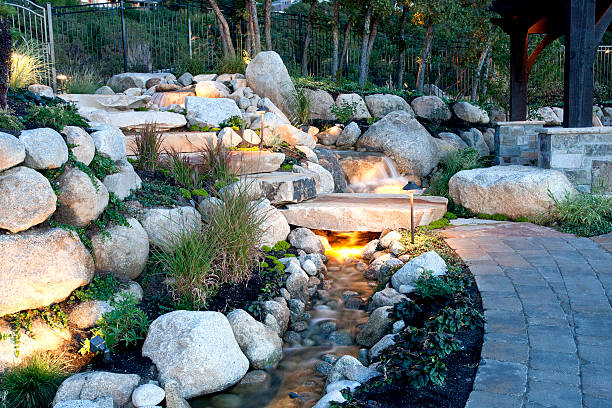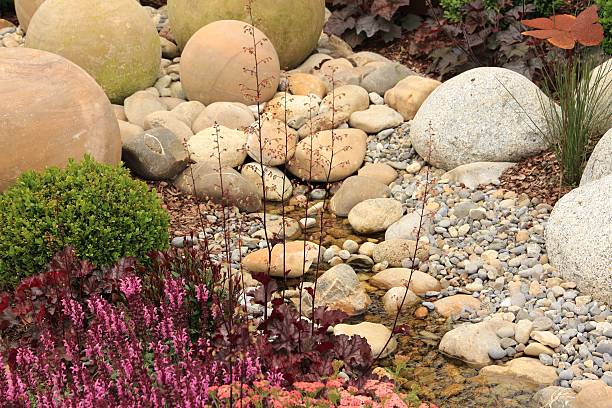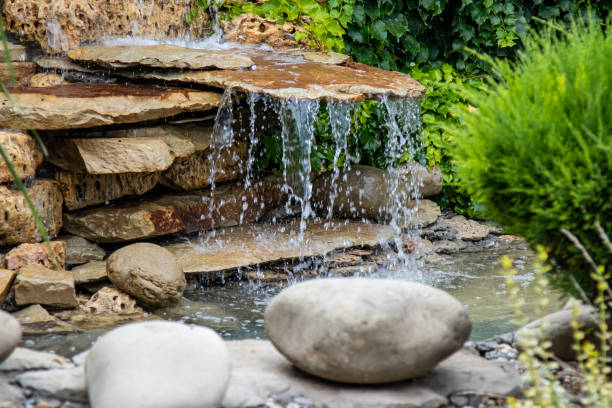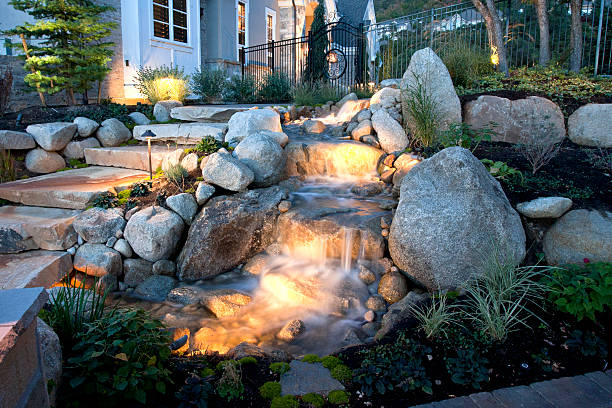Rock gardens are an increasingly popular landscaping choice for homeowners and garden enthusiasts seeking a unique, low-maintenance, and visually appealing outdoor space. Also known as alpine gardens, these designs combine natural rocks and carefully selected plants to create a harmonious and sustainable landscape. Rock gardens not only provide aesthetic beauty but also offer numerous environmental and practical benefits, making them a perfect addition to any home or public garden.
In this article, we’ll explore what makes rock gardens special, how to design and build one, the best plants to use, and why they’re a smart, sustainable choice for modern gardeners.



1. What is a Rock Garden?
A rock garden is a landscape feature that incorporates rocks, stones, and boulders, often arranged to mimic natural mountainous or rocky environments. The spaces between the rocks are filled with hardy plants, typically those adapted to dry, rocky conditions. Rock gardens originated from alpine gardening, which focused on growing plants from high-altitude regions.
Rock gardens can range in size from small, contained beds to expansive areas that dominate an entire yard. They can be highly structured, with carefully placed rocks and plants, or more natural, simulating the randomness found in nature. The key to a successful rock garden is balance—balancing the rocks and plants so that they work together to create a visually pleasing and functional landscape.
2. Why Choose a Rock Garden?
Rock gardens are becoming a go-to choice for homeowners and landscapers due to their many advantages. Here are a few reasons why rock gardens might be the perfect choice for your yard:
a. Low Maintenance
One of the most significant advantages of rock gardens is their low-maintenance nature. Once established, they require less watering, weeding, and general upkeep compared to traditional lawns or flower gardens. The rocks help retain moisture in the soil and reduce the need for frequent watering, while the hardy, drought-tolerant plants used in rock gardens can thrive with minimal care.
- Drought-Resistant Landscaping: In areas prone to drought or where water conservation is a priority, rock gardens are an excellent solution. By selecting plants that require little water, you can create a garden that stays beautiful without excessive watering.
- Minimal Weeding: Rocks and gravel act as natural barriers to weeds, reducing the time you’ll spend pulling out unwanted plants.
b. Eco-Friendly
Rock gardens are an environmentally friendly option. They reduce water consumption, limit the need for chemical fertilizers and pesticides, and can help combat soil erosion. In addition, the use of native plants in rock gardens encourages local biodiversity, attracting beneficial insects like bees and butterflies.
- Sustainable Gardening: With the increasing focus on sustainability, rock gardens are a great way to create an eco-friendly landscape that minimizes environmental impact.
- Preventing Soil Erosion: The rocks and plants in a rock garden help stabilize the soil, preventing erosion, especially on sloped or uneven terrain.
c. Aesthetic Appeal
The natural beauty of rock gardens is undeniable. The combination of rocks, boulders, and a variety of plants creates visual interest and texture. A well-designed rock garden can serve as a focal point in your yard, drawing attention to its unique design. The variety of plants used, from creeping ground covers to tall, spiky perennials, can add layers of height and color, making the garden visually dynamic.
- Texture and Contrast: The interplay between the rugged rocks and soft plants creates a stunning contrast that can enhance the overall appearance of your garden. You can also use different types of rocks, like granite, limestone, or slate, to add color and texture.
- Year-Round Beauty: With the right plant selection, your rock garden can look attractive throughout the year. Many alpine and drought-tolerant plants bloom in the spring and summer, while evergreens provide color and structure during the colder months.
d. Versatility
Rock gardens can be adapted to fit any space, from small urban courtyards to expansive country yards. Whether you have a steep slope, an uneven terrain, or a flat, open space, a rock garden can be customized to suit your environment. You can also incorporate other elements, such as water features, statues, or garden paths, to make your rock garden truly unique.
- Small Spaces: If you have limited yard space, a small rock garden can be an elegant solution that adds greenery and character without requiring too much room.
- Slopes and Hillsides: Rock gardens are ideal for sloped areas, as the rocks can help prevent erosion and create tiered planting spaces that add depth to the landscape.
3. How to Design a Rock Garden
Creating a rock garden requires careful planning, especially if you want it to look natural and harmonious. Here’s a step-by-step guide to designing your rock garden:
a. Choose the Location
The first step in designing a rock garden is selecting the right location. Look for an area that gets plenty of sunlight, as most rock garden plants thrive in sunny, well-drained conditions. If you have a naturally rocky or sloped area in your yard, that’s a great place to start, as it will mimic the natural environment that rock garden plants prefer.
- Sunlight and Drainage: Choose a spot that receives at least six hours of sunlight a day and has well-drained soil. If the soil in your yard is clay-heavy, you may need to amend it with sand or gravel to improve drainage.
- Creating Elevation: If your yard is flat, consider creating artificial mounds or slopes using rocks and soil. This will give your rock garden a more natural appearance and provide better drainage for your plants.
b. Select Your Rocks
The rocks are the backbone of your rock garden, so choose them carefully. Look for a variety of sizes and types of rocks to create visual interest. Large boulders can serve as focal points, while smaller rocks can be used to define paths or borders.
- Natural vs. Manufactured Rocks: While natural rocks like limestone, sandstone, and granite are popular choices, you can also use manufactured stone or concrete if natural rocks are not available.
- Arranging the Rocks: Place the largest rocks first, as they will serve as the foundation of your garden. Position them at different angles to mimic the randomness of natural rock formations. Once the large rocks are in place, fill in with smaller stones and gravel.
c. Choose the Right Plants
Rock garden plants should be hardy, drought-tolerant, and able to thrive in rocky, well-drained soil. Many alpine plants, succulents, and ground covers are ideal choices for a rock garden.
- Alpine Plants: These plants are native to mountainous regions and are well-suited to the rocky, well-drained soil of a rock garden. Examples include Saxifraga, Thyme, Sedum, and Aubrieta.
- Succulents: Succulents, such as Hens and Chicks (Sempervivum) and Sedum, are drought-tolerant plants that thrive in the dry conditions of a rock garden. They come in a variety of shapes and colors, adding visual interest to the garden.
- Perennials and Shrubs: For additional height and structure, consider adding low-growing perennials or dwarf shrubs like Lavender, Juniper, or Artemisia. These plants will provide year-round interest and create layers in your garden.
d. Incorporate Mulch and Gravel
Mulch and gravel play an essential role in rock gardens. They help with moisture retention, weed suppression, and aesthetics. Spread a layer of gravel or small rocks around your plants to create a polished look and improve drainage.
- Gravel Paths: Consider adding a gravel path or walkway to your rock garden. This will make the garden more accessible and can add to the overall design.
- Mulch for Weed Control: Use a layer of mulch, such as pea gravel or bark chips, to suppress weeds and keep your garden looking neat.
4. Maintaining Your Rock Garden
Rock gardens are relatively low-maintenance, but they still require some upkeep to keep them looking their best. Here are a few tips for maintaining your rock garden:
a. Watering
Rock garden plants are typically drought-tolerant, but they will need watering during dry spells, especially when first planted. Water deeply but infrequently to encourage deep root growth.
b. Weeding
While rock gardens tend to suppress weeds, some may still pop up, especially in the early stages. Regularly check your garden for weeds and remove them by hand to prevent them from taking over.
c. Pruning and Deadheading
To keep your rock garden looking tidy, prune any overgrown plants and remove spent flowers (deadheading). This will encourage new growth and keep your garden neat.
5. Rock Garden Design Ideas
Rock gardens are highly versatile, and there are endless ways to design them. Here are a few ideas to inspire you:
- Japanese Zen Garden: Incorporate raked gravel, strategically placed rocks, and minimalist plants like moss and bamboo for a serene, Zen-like atmosphere.
- Desert Rock Garden: Use cacti, succulents, and drought-tolerant plants to create a desert-themed garden that thrives in hot, dry climates.
- Water Features: Add a small waterfall, pond, or stream to your rock garden for added tranquility and movement.
Conclusion
Rock gardens offer a perfect combination of beauty, sustainability, and low maintenance. Whether you’re looking for a water-saving landscape, a way to add interest to a slope, or just a garden that requires less upkeep, rock gardens can provide the solution. With careful planning, the right choice of rocks, and well-suited plants, your rock garden can be a year-round masterpiece that enhances the aesthetic appeal of your outdoor space.







